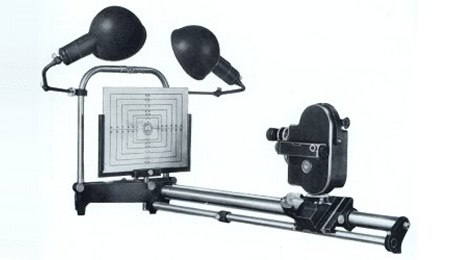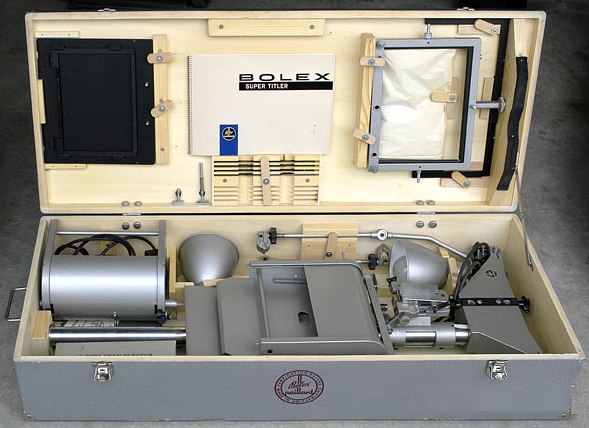Bolex H16 User
For Practical Bolex H16 Filming
Super Titling Bench
Bolex Product Codes:- TITRA, TIPLO, TITEL, EUFEL
 The
Bolex Super Titling bench was designed and introduced in the early 50s
and allowed anybody to make professional titles using there Bolex camera.
The
Bolex Super Titling bench was designed and introduced in the early 50s
and allowed anybody to make professional titles using there Bolex camera.
The titlers design remained roughly the same throughout manufacturer. The only improvements being the use of a better metal finnish and the introduction of the rapid attachment device onto the titler. Instead of using the metal plate attachment method (as discussed in the tripod section).
All the parts that make up the titler comes in a big custom designed wooden box. I'll let the Technical Manager of Paillard S.A. Mr Robert Grosjean tell you all about it
Bolex Reporter Article on the introduction of the Super Titler Spring 1951
The importance of the part played by titles in a film cannot be overemphasised, for they provide movie-maker with an ideal means of imparting a personal touch to their films. To do so, however, the moviemaker must feel quite free to exercise his or her imagination and inventive spirit to the utmost, and must have a wide range of trick effects available.
The Bolex Movie Titler is the only one of its type with so many professional features. It's ingenious design speeds up and simplifies the operators work considerably. In particular the need for a lengthy preliminary adjustment of the camera position, and the use of flimsy and hastily contrived settings, with their ever-present risk of getting unsatisfactory results for one's pains, are entirely eliminated. Shooting titles is no longer a painful necessity, but a real pleasure.

The most varied cinematography tricks: traveling, fixed or moving titles in one or in several planes, life-size subjects with a background of miniature scenery, Super impositions and so forth will easily and accurately be produced, and the movie-maker thus has a vast number of beautiful effects within reach. Its comprehensive set of components makes the Bolex Titler extremely adaptable especially for scientific or advertising films and animated cartoons.
 The
Bolex Movie Titler can be set up either vertically or horizontally, and
operates equally well in either position. One of its supporting feet is
adjustable, to insure stability and an absolute level background. One
of the titlers main attractive features is that it can be supplied either
alone (TITRA) as a basic titling set intended chiefly for making simple
titles, or equipped with a set of accessories (TITOU an TIPLO) for the
most complicated trick effects when shooting fancy titles or special types
of settings.
The
Bolex Movie Titler can be set up either vertically or horizontally, and
operates equally well in either position. One of its supporting feet is
adjustable, to insure stability and an absolute level background. One
of the titlers main attractive features is that it can be supplied either
alone (TITRA) as a basic titling set intended chiefly for making simple
titles, or equipped with a set of accessories (TITOU an TIPLO) for the
most complicated trick effects when shooting fancy titles or special types
of settings.
It is fitted with a camera cradle designed to take any make of 16mm or 8mm cine camera, and it can also be used with still cameras, such as Leica or Speed Graphic. The camera cradle has two positions the first inclined position is intended for use with Bolex H16 and H8 Cameras only, and provides full parallax correction, whereas the second or horizontal position is intended for use with a Bolex L8 cameras and cameras of other makes.
The great advantage of the camera cradle is the fact that it allows one to calibrate to the individual characteristics of each camera, as well as the lens with which it is fitted. Really accurate framing of the title in the taking aperture can always be obtained, no matter what the distance from camera to Subject may be. Traveling shots become child's play, and the desired effect is obtained without any hitches. What is more, the camera can be set up on the titler very easily, and always takes up its correct position instantaneously and accurately. This position need only be adjusted once and for all. The subject may be shot straightaway, without the need for spending a lot of time on framing.
The mounting frame for making simple titles on a fixed plane bracket (opaque or ground glass background) is of a novel design, allowing the movie-maker to vary the size of the titles. The three available sizes include provision for shooting postcard size titles, always a useful feature. They correspond to the field provided by normal focus taking lenses when used at certain set distances from the title frame. They are also proportional to the size of lettering usually found on the market, and lend themselves easily to making up all sorts of titles, as well as backgrounds using illustrations and photographs. The height of the frame for each of the three sizes is determined by reference to Preset Guide marks, which show the height to which the frame must be set so that the title will be correct centred.

The twin reflectors are mounted on jointed arms and can be set in any position according to the angle of lighting required. The hoods can be adjusted to suit any size of lamp up to 500 watts. The reflector mounting Attachments have been designed so that they can be placed in position at any time before or after the subject has been set up, either on the special frame provided for this purpose or on one of the tubes of the optical bench, in front of or behind the camera. The reflector mounting frame can also be adjusted so as to light not only a subject set upon the Titler, but also titles on other subjects set-up beyond the bench proper i e walls, posters etc for shooting interior scenes and so on.
 A
spring mounted metal tape measure automatically indicates the distance
between the title and the plane of the film for any position of the camera
cradle. This device will be found extremely useful, particularly when
shots have to be made in subdued lighting with the diaphragm Wide Open
and a correspondingly shallow depth of field. A sliding stop wing which
fits onto the centre bar of the optical bench serves as a forward or back
stop, limiting the movement of the camera cradle when traveling shots
are being made.
A
spring mounted metal tape measure automatically indicates the distance
between the title and the plane of the film for any position of the camera
cradle. This device will be found extremely useful, particularly when
shots have to be made in subdued lighting with the diaphragm Wide Open
and a correspondingly shallow depth of field. A sliding stop wing which
fits onto the centre bar of the optical bench serves as a forward or back
stop, limiting the movement of the camera cradle when traveling shots
are being made.
Laying out the titles is made easy by the use of lettering and numbering in various colours, made of felt or Cork by arranging the Lighting accordingly, the latter may be made to stand out in relief a most attractive effect. Whether it is wished to produce a plain title, or one with complex decorative effects, the layout of the text should always be done with the greatest care. This task can be rendered considerably easier by using the special framing card, made of a transparent material.
The axis of this card provide an immediate indication
of where the centre of the title lies, and it is also marked ![]() out
with rectangles of different sizes which are of assistance in laying out
the work. The card will also be found very useful in making any other
adjustments that may be required.
out
with rectangles of different sizes which are of assistance in laying out
the work. The card will also be found very useful in making any other
adjustments that may be required.